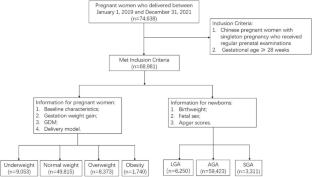Seeking the optimal gestational weight gain according to the pre-pregnancy body mass index: a cross-sectional study from Shanghai, China
IF 3.6
3区 医学
Q2 NUTRITION & DIETETICS
引用次数: 0
Abstract
Maternal nutritional status is closely related to fetal intrauterine development and an abnormal birth weight increases various disease risks across life stages. To better guide pregnancy weight gain, we aimed to explore the optimal weight gain for pregnant women with different body mass indexes (BMIs). This retrospective cohort study included 68,981 women with singleton live birth between January 2017 and October 2021 in maternity centres in Shanghai, China. The fluctuations of the incidence of small and large for gestational age (small for gestational age (SGA) and LGA, respectively) were recorded at different maternal pre-pregnancy BMI (p-BMI) and different gestational weight gain (GWG) groups to find the lowest point of abnormal fetal weight incidence. The optimal GWG was then determined using a linear regression equation. The lowest risk of LGA/SGA was associated with a maternal p-BMI of 19.46 kg/m2. For pregnant women with maternal p-BMI below 24 kg/m2, we confirmed an optimal GWG linear equation: opt GWG (kg) = −1.94 × p-BMI (kg/m²) + 51, which showed an excellent degree of fit. Women who were overweight and obese could not achieve the lowest risk of LGA/SGA despite controlling their GWG; hence, their BMI should be normalized before pregnancy. By merely using the pre-pregnancy BMI, this study has established the optimal GWG equation, with the goal of achieving the appropriate fetal gestational age. It is a practical measure to ensure desirable pregnancy outcomes and meet the health economics requirements.


根据孕前体重指数寻求最佳妊娠体重增加:一项来自中国上海的横断面研究
目的母亲的营养状况与胎儿宫内发育密切相关,出生体重异常会增加整个生命阶段的各种疾病风险。为了更好地指导孕期增重,我们旨在探索不同体重指数(BMI)孕妇的最佳增重。方法这项回顾性队列研究纳入了2017年1月至2021年10月期间在中国上海产科中心分娩的68981名单胎活产妇女。研究记录了不同孕前 BMI(p-BMI)和不同妊娠增重(GWG)组别下胎龄过小和胎龄过大(分别为胎龄过小(SGA)和胎龄过大(LGA))发生率的波动情况,以找到胎儿体重异常发生率的最低点。结果 孕妇 p-BMI 为 19.46 kg/m2 时,发生 LGA/SGA 的风险最低。对于孕产妇 p-BMI 低于 24 kg/m2 的孕妇,我们确认了最佳 GWG 线性方程:最佳 GWG(kg)=-1.94 × p-BMI (kg/m²)+ 51,该方程显示出极佳的拟合度。尽管控制了 GWG,但超重和肥胖妇女仍无法达到 LGA/SGA 的最低风险;因此,她们的 BMI 应在孕前恢复正常。这是一项切实可行的措施,既能确保理想的妊娠结果,又能满足卫生经济学的要求。
本文章由计算机程序翻译,如有差异,请以英文原文为准。
求助全文
约1分钟内获得全文
求助全文
来源期刊
CiteScore
10.60
自引率
2.10%
发文量
189
审稿时长
3-6 weeks
期刊介绍:
The European Journal of Clinical Nutrition (EJCN) is an international, peer-reviewed journal covering all aspects of human and clinical nutrition. The journal welcomes original research, reviews, case reports and brief communications based on clinical, metabolic and epidemiological studies that describe methodologies, mechanisms, associations and benefits of nutritional interventions for clinical disease and health promotion.
Topics of interest include but are not limited to:
Nutrition and Health (including climate and ecological aspects)
Metabolism & Metabolomics
Genomics and personalized strategies in nutrition
Nutrition during the early life cycle
Health issues and nutrition in the elderly
Phenotyping in clinical nutrition
Nutrition in acute and chronic diseases
The double burden of ''malnutrition'': Under-nutrition and Obesity
Prevention of Non Communicable Diseases (NCD)

 求助内容:
求助内容: 应助结果提醒方式:
应助结果提醒方式:


